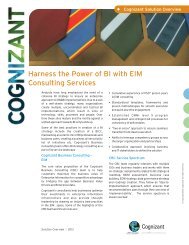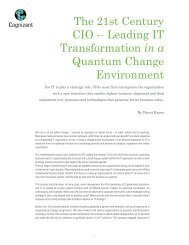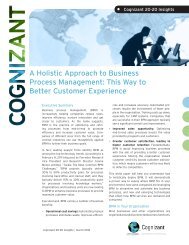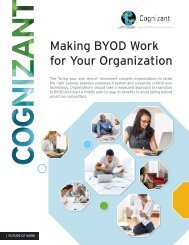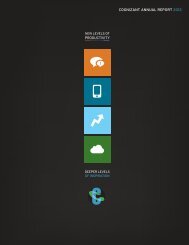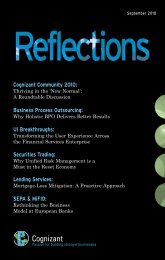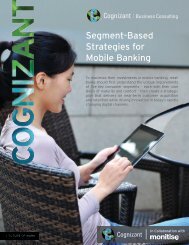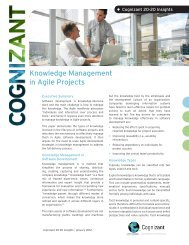The Journey Toward the Software-Defined Data Center - Cognizant
The Journey Toward the Software-Defined Data Center - Cognizant
The Journey Toward the Software-Defined Data Center - Cognizant
You also want an ePaper? Increase the reach of your titles
YUMPU automatically turns print PDFs into web optimized ePapers that Google loves.
• Self-heal solutions: In an SDDC, automationservices wherever possible will identify,diagnose, correlate and isolate incidents, andresolve <strong>the</strong>m.• Orchestration and third-party plug-ins:Workflow through orchestration tools andplug-in/APIs with third-party products isneeded to control data center resource consumptionin an SDDC. <strong>The</strong> management andmonitoring stack will <strong>the</strong>refore need to beinterleaved through <strong>the</strong>se APIs to apply intelligenceand predict <strong>the</strong> behavior of <strong>the</strong> systems.• Analytics engine and data store: Withprogrammatically controlled infrastructurearchitecture, <strong>the</strong>re will be huge amountsof audit, log and change management datagenerated as resource consumption changes.This data surge will require a database withan ability to cull relevant information feedingvarious systems for information retrievaland reporting. Analytics and intelligence tocorrelate events, along with a comprehensivedata store capability, will be in high demand insuch scenarios.Adoption PathDepending on <strong>the</strong> infrastructure’s maturity,<strong>the</strong> enterprise needs to draw up a roadmap toleverage <strong>the</strong> benefits of SDDC. While SDDC itselfis evolving, enterprises must take a proactiveview and consider a data center designed for <strong>the</strong>future, designed for change and nimble enough toadapt to ever-changing technology levers.Figure 9 depicts <strong>the</strong> data center maturity curveneeded for organizations to take initial stepstoward SDDC.<strong>The</strong> “inception” to “functioning data center”stage essentially depicts <strong>the</strong> level of virtualizationadopted in <strong>the</strong> enterprise. <strong>The</strong> “functioningdata center” state to “performing data center”state depicts improvements in virtualizationmaturity coupled with active automation, selfserviceportals and converged infrastructure.“Envisaged SDDC” represents <strong>the</strong> future goal of adata center integrated with legacy infrastructureand aligned with complete automated operationsconnected to unified fabric. While we know that atrue software-defined data center does not existcurrently, <strong>the</strong> steps taken will serve as a businessdifferentiator for enterprises and bring aboutflexibility and fungibility across IT functions comprisingarchitecture and operations. Enterprisesimplementing greenfield data center builds areoften <strong>the</strong> prime candidates to leverage <strong>the</strong> SDDCconcept by aligning to <strong>the</strong> principles of virtualizationin <strong>the</strong>ir infrastructure footprints.SDDC Adoption Roadmap• Provide a dynamic infrastructure througha service catalog driven by portal.• Highly visible and proactive operationswith an automation architecture.25% Virtualized• Virtualization used indevelpment and testenvironments.• No data centerconsolidation/serversprawls.• Infrastructure dedicatedto applications.75% VirtualizedTipping Point• Need to extend virtualizationto tier-one application.• Automation-led provisioningof individual systems basedon predefined templates.• Virtualization categories(machine, storage, network,app) run independently.• Proactive availability andperformance monitoring.95% Virtualized• Self-service portals and welldefined service catalogsmapped to application stacks.• Business requirements andSLAs drive computeconfigurations.• Full stack integrationorchestrated throughoptimized process andtechnology.• Converged infrastructure andconverged management.• Active automation.• Service portals provide businessservices that directly map tounderlying IT.• Converged infrastructure and unifiedfabric including facilities withmanagement.• Legacy infrastructure integrationcapabilities.• Virtual resources predictivelyallocated based on business need.• Resource lifecycle managed bypolicy and cost justification.• Dynamic compute configuration basedon changing business needs and SLAs.• Dynamic business service mapping toinfrastructure elements. Real-timevisibility to service availability andperformance.Inception Functioning DC Performing DC Envisaged SDDCFigure 9cognizant 20-20 insights 8



